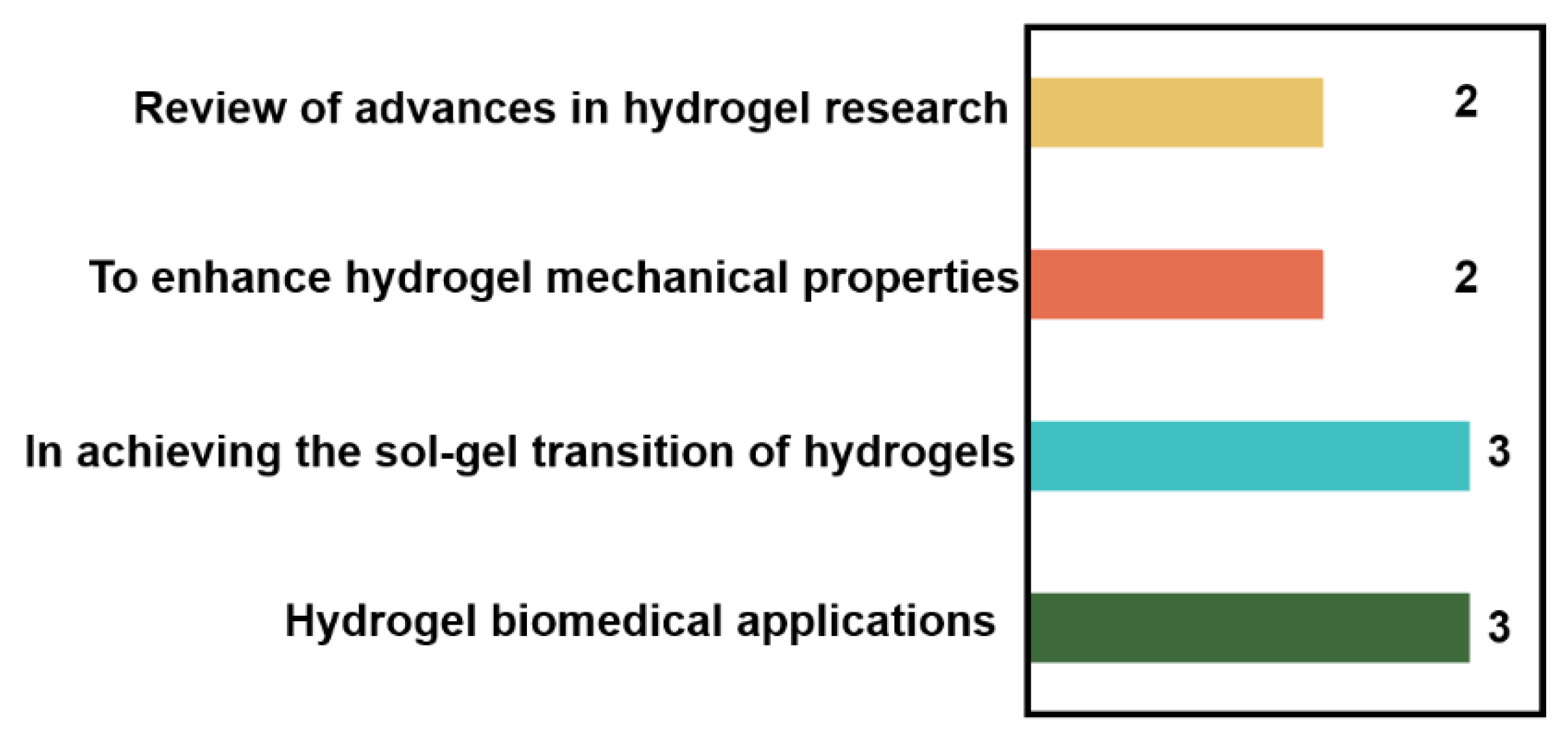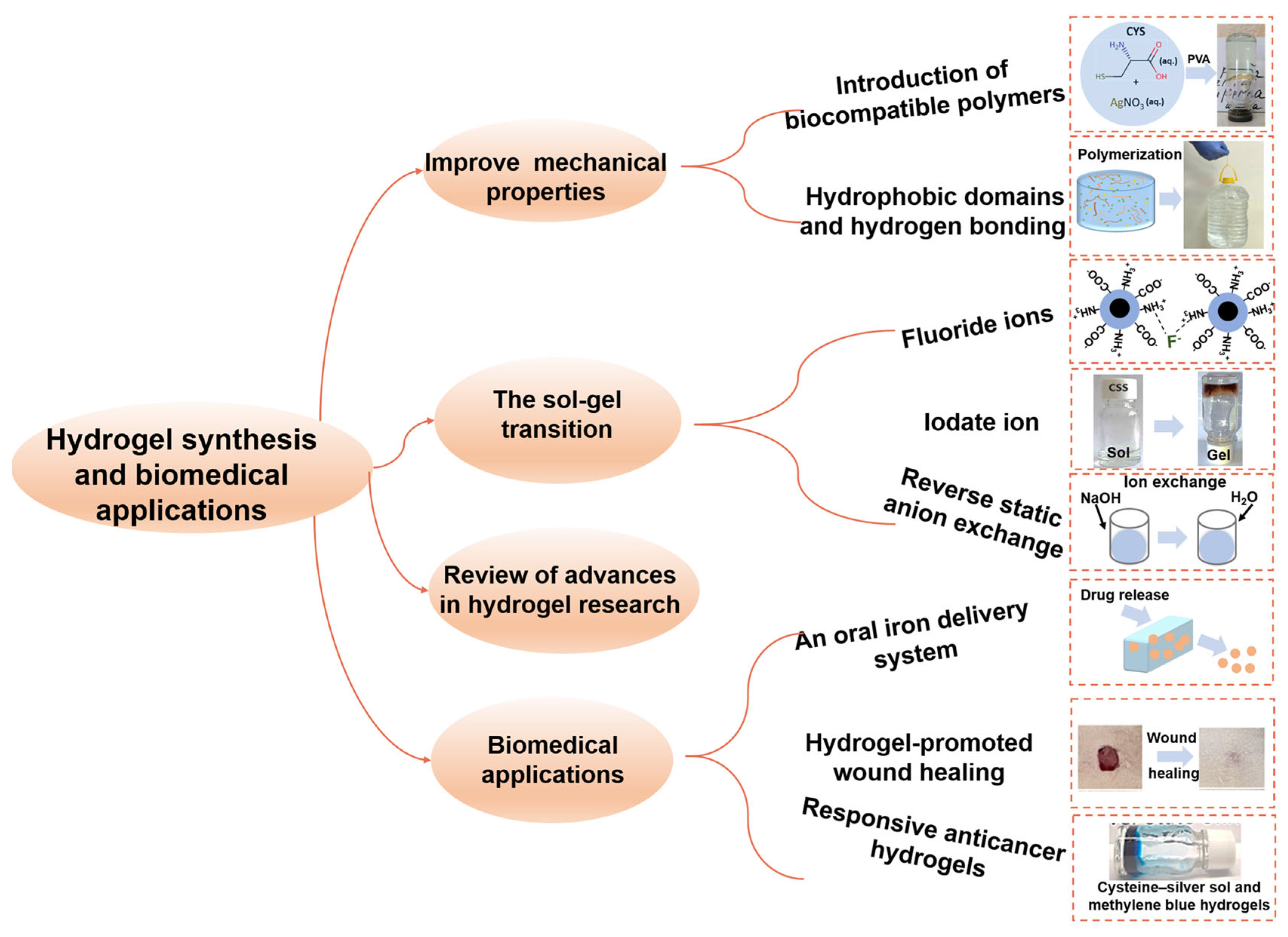Recent Progress in Hydrogel Synthesis and Biomedical Applications
1. Introduction
2. Contributions
3. Conclusions
Author Contributions
Conflicts of Interest
References
- Zhang, Y.S.; Khademhosseini, A. Advances in engineering hydrogels. Science 2017, 356, eaaf3627. [Google Scholar] [CrossRef] [PubMed]
- Wei, L.; Huang, J.; Yan, Y.; Cui, J.; Zhao, Y.; Bai, F.; Liu, J.; Wu, X.; Zhang, X.; Du, M. Substrate-Independent, Mechanically Tunable, and Scalable Gelatin Methacryloyl Hydrogel Coating with Drag-Reducing and Anti-Freezing Properties. ACS Appl. Polym. Mater. 2022, 4, 4876–4885. [Google Scholar] [CrossRef]
- Feng, W.; Wang, Z. Tailoring the Swelling-Shrinkable Behavior of Hydrogels for Biomedical Applications. Adv. Sci. 2023, 10, 2303326. [Google Scholar] [CrossRef]
- Liu, X.; Liu, J.; Lin, S.; Zhao, X. Hydrogel machines. Mater. Today 2020, 36, 102–124. [Google Scholar] [CrossRef]
- Li, L.; Wu, P.; Yu, F.; Ma, J. Double network hydrogels for energy/environmental applications: Challenges and opportunities. J. Mater. Chem. A 2022, 10, 9215–9247. [Google Scholar] [CrossRef]
- Ma, Y.; Tang, Y.; Fan, J.; Sun, T.; Qiu, X.; Wei, L.; Zhang, X. A pH-responsive dual-network biopolysaccharide hydrogel with enhanced self-healing and controlled drug release properties. RSC Adv. 2024, 14, 38353–38363. [Google Scholar] [CrossRef] [PubMed]
- Wei, L.; Yang, Y.; Qiu, X.; Shen, J.; Zhao, Y.; Zhang, X.; Hu, B.; Yang, T.; Fu, H.; Chen, S.; et al. Self-Polymerized Tough and High-Entanglement Zwitterionic Functional Hydrogels. Small 2024, 20, 2405789. [Google Scholar] [CrossRef] [PubMed]
- Zhu, J.; Cheng, H.; Zhang, Z.; Chen, K.; Zhang, Q.; Zhang, C.; Gao, W.; Zheng, Y. Antibacterial Hydrogels for Wound Dressing Applications: Current Status, Progress, Challenges, and Trends. Gels 2024, 10, 495. [Google Scholar] [CrossRef] [PubMed]
- Ciulla, M.G.; Massironi, A.; Sugni, M.; Ensign, M.A.; Marzorati, S.; Forouharshad, M. Recent Advances in the Development of Biomimetic Materials. Gels 2023, 9, 833. [Google Scholar] [CrossRef] [PubMed]
- Vishnevetskii, D.V.; Mekhtiev, A.R.; Averkin, D.V.; Polyakova, E.E. Cysteine–Silver–Polymer Systems for the Preparation of Hydrogels and Films with Potential Applications in Regenerative Medicine. Gels 2023, 9, 924. [Google Scholar] [CrossRef] [PubMed]
- Ugrinovic, V.; Markovic, M.; Bozic, B.; Panic, V.; Veljovic, D. Physically Crosslinked Poly(methacrylic acid)/Gelatin Hydrogels with Excellent Fatigue Resistance and Shape Memory Properties. Gels 2024, 10, 444. [Google Scholar] [CrossRef] [PubMed]
- Vishnevetskii, D.V.; Andrianova, Y.V.; Polyakova, E.E.; Ivanova, A.I.; Mekhtiev, A.R. Fluoride-Ion-Responsive Sol–Gel Transition in an L-Cysteine/AgNO3 System: Self-Assembly Peculiarities and Anticancer Activity. Gels 2024, 10, 332. [Google Scholar] [CrossRef] [PubMed]
- Vishnevetskii, D.V.; Polyakova, E.E.; Andrianova, Y.V.; Mekhtiev, A.R.; Ivanova, A.I.; Averkin, D.V.; Alekseev, V.G.; Bykov, A.V.; Sulman, M.G. L-Cysteine/Silver Nitrate/Iodate Anions System: Peculiarities of Supramolecular Gel Formation with and Without Visible-Light Exposure. Gels 2024, 10, 809. [Google Scholar] [CrossRef] [PubMed]
- Mrohs, T.B.; Weichold, O. A Simple Preparation of Crosslinked, Highly Alkaline Diallyldimethylammonium Hydroxide Hydrogel Particles via Inverse Static Anion Exchange. Gels 2024, 10, 743. [Google Scholar] [CrossRef] [PubMed]
- Orlova, P.; Meshkov, I.; Latipov, E.; Vasiliev, S.; Mikheev, I.; Ratova, D.-M.; Kalinina, A.; Muzafarov, A.; Le-Deygen, I. Cyclodextrin—Polymethylsilsesquioxane Combined System as a Perspective Iron Delivery System for Oral Administration. Gels 2024, 10, 564. [Google Scholar] [CrossRef] [PubMed]
- Lapmanee, S.; Bhubhanil, S.; Charoenphon, N.; Inchan, A.; Bunwatcharaphansakun, P.; Khongkow, M.; Namdee, K. Cannabidiol-Loaded Lipid Nanoparticles Incorporated in Polyvinyl Alcohol and Sodium Alginate Hydrogel Scaffold for Enhancing Cell Migration and Accelerating Wound Healing. Gels 2024, 10, 843. [Google Scholar] [CrossRef] [PubMed]
- Vishnevetskii, D.V.; Metlin, F.A.; Andrianova, Y.V.; Polyakova, E.E.; Ivanova, A.I.; Averkin, D.V.; Mekhtiev, A.R. Preparation of Composite Hydrogels Based on Cysteine–Silver Sol and Methylene Blue as Promising Systems for Anticancer Photodynamic Therapy. Gels 2024, 10, 577. [Google Scholar] [CrossRef] [PubMed]



Disclaimer/Publisher’s Note: The statements, opinions and data contained in all publications are solely those of the individual author(s) and contributor(s) and not of MDPI and/or the editor(s). MDPI and/or the editor(s) disclaim responsibility for any injury to people or property resulting from any ideas, methods, instructions or products referred to in the content. |
© 2025 by the authors. Licensee MDPI, Basel, Switzerland. This article is an open access article distributed under the terms and conditions of the Creative Commons Attribution (CC BY) license (https://creativecommons.org/licenses/by/4.0/).
Share and Cite
Wei, L.; Huang, J. Recent Progress in Hydrogel Synthesis and Biomedical Applications. Gels 2025, 11, 456. https://doi.org/10.3390/gels11060456
Wei L, Huang J. Recent Progress in Hydrogel Synthesis and Biomedical Applications. Gels. 2025; 11(6):456. https://doi.org/10.3390/gels11060456
Chicago/Turabian StyleWei, Luxing, and Jun Huang. 2025. "Recent Progress in Hydrogel Synthesis and Biomedical Applications" Gels 11, no. 6: 456. https://doi.org/10.3390/gels11060456
APA StyleWei, L., & Huang, J. (2025). Recent Progress in Hydrogel Synthesis and Biomedical Applications. Gels, 11(6), 456. https://doi.org/10.3390/gels11060456




